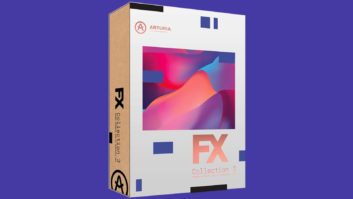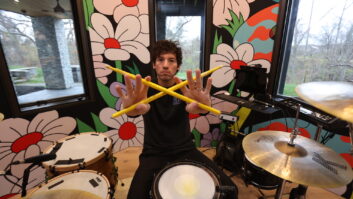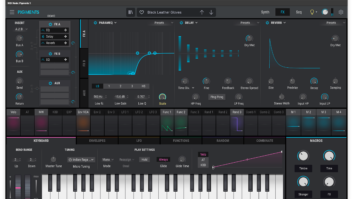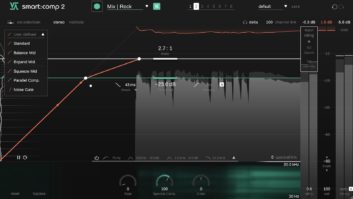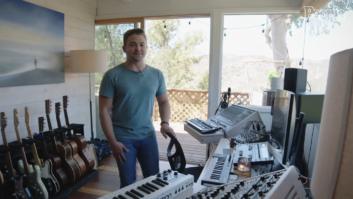
In addition to its prowess as a software design company, the French manufacturer Arturia now manufactures quite a few hardware products, as well, including drum machines, MIDI controllers, synths, and, lately, audio interfaces.
Recently, the company expanded its AudioFuse series of USB interfaces, adding two new units for the desktop. The AudioFuse 8Pre, reviewed here, is the only rackmountable model in the AudioFuse series (it can also be configured for tabletop use) and offers eight mic preamps, as well as two pairs of ADAT I/O for expandability. It joins AudioFuse Studio (four mic preamps) and the original AudioFuse (two mic pres), which will soon be re-released as the AudioFuse Rev 2.
All the AudioFuse models use the company’s proprietary DiscretePro mic preamps, which feature impressive specs for noise (< -131.5dB signal-to-noise ratio) and dynamic range (119.3 dB). Arturia even measures the preamps in each unit and includes a certificate with the exact noise (EIN), frequency response and gain range unique to yours.
The preamps in the 8Pre are all on combo jacks and can take both mic and line signals. Channels 1 and 2 can also handle high-impedance sources like guitars and basses.
The 8Pre comes with rack ears, which are unattached when you first open the box. You can mount them horizontally to use in a rack or vertically as legs for a tabletop setup. If you choose the latter, you also need to attach the included back feet that screw in on the bottom of the unit toward the back. I appreciate this smart design, although I found the small mounting screws for the rack ears to be challenging to handle and manipulate.
COMBO PLATTER
All but two of the combo jacks are on the back panel, but Arturia conveniently placed individual channel-specific controls, including Gain knobs and switches for 48V phantom power, Phase and Pad. The –20 dB Pad switches are handy and can also be turned into +10 dB Boost switches by holding the button for several seconds until the switch turns red.
Each channel also features a seven-step LED ladder meter that lights up green for the first five steps, orange when it gets to –3 dB and red when it clips.
A small master section on the right side includes speaker and headphone gain knobs, as well as 1/4-inch TRS and 1/8-inch (3.5mm) TRS headphone jacks. You can use both simultaneously, but they’re not independent. They can either be set to monitor the Main mix or the Cue mix. You set up the latter with the included AFCC software.
The monitoring section also features both Mono and Mute buttons. However, there is no talkback circuit, nor does it have a Dim function.
The farthest-right controls on the front are switches for setting the clock (sampling) rate, sync source (the 8Pre offers reliable performance when used as the master clock) and toggling the unit between USB and ADAT modes. USB mode offers more flexible routing options and is what you would use for most situations, unless the AudioFuse 8Pre is serving as a slave to another ADAT-equipped unit.
Above the Mode switch is a backlit button with the Arturia logo, which is both a power switch and a switch for turning on and off the AFCC software. A brief press turns on the unit. Once it’s on, a quick press launches the software. If AFCC is on, a quick press makes it quit. Turning off the AudioFuse 8Pre itself requires that you to press and hold the button for five seconds.
The manual is well-written and comprehensive. The AFCC software is covered to some extent in the main manual, but also has its own dedicated user guide.
GET CONNECTED
The rear of the unit includes mic/line combo jacks for all eight input channels. The rear inputs for Channels 1 and 2 are duplicates of the two on the front, and also include 1/4-inch TRS insert inputs and outputs.
The front versions of Channels 1 and 2 have priority. So, for example, if you plug something into Channel 1 in the back, and then connect another source into Channel 1 in the front, the front will be active. The inserts for Channels 1 and 2 will work regardless of whether you connected your source in the front or back.

The rear panel also features 10 balanced 1/4-inch TRS output jacks. Outputs 1 and 2 are the Main output jacks. Outputs 3 through 8 are additional line outputs. The other two are the Left and Right Speaker outputs.
Other connectors on the back include Word Clock in and out on BNC jacks, a jack for the included power adapter and a USB 3 connector. If your computer has only USB 2.0 jacks, don’t worry; it’s backward-compatible. Arturia even includes two USB cables: one USB Type C for use on the latest computers, and one with a Type A connector on one end for USB 2.0.
Finally, you get two pairs of ADAT input and output jacks. Between the two, you can add up to 16 inputs over Lightpipe at 44.1 or 48 kHz sampling rates, or up to eight at 88.2 kHz and 96 kHz. You’ll notice I didn’t mention 176.4 kHz or 192 kHz. That’s because the AudioFuse 8Pre doesn’t support anything above 96 kHz. Considering that the bulk of users work at either 44.1 or 48, the lack of ultra-high sampling rates is not a major issue.
CONTROL FREAK
The AFCC software is a key part of the AudioFuse 8Pre workflow. It provides extended functionality, as well as some redundancy to the controls on the hardware unit.
Several functions, including channel input gain level, monitor level and headphone level, are only adjustable on the hardware. They don’t go through AFCC because they’re strictly analog functions.
As anyone who has used control software for audio interfaces knows, these applications tend to be the opposite of user-friendly. Fortunately, AFCC is relatively straightforward, as they go. It features three main sections: the Input zone, the Monitoring Mix zone and the Output zone, which you can open individually. When you have more than one open, they stack vertically.
The Input zone shows you the eight front panel inputs in detail, including level meters and switches for 48V phantom power, Pad, Instrument (for channels 1 and 2 only) and Phase, which mirror those on the unit itself. For the digital inputs (if you’re using the ADAT I/O), you only get level meters.
The Monitoring Mix zone makes it pretty easy to set up the cue mix. It allows you to combine direct-monitored input sources with the USB audio coming back from you DAW. You can adjust level, pan, and even name each channel in the mix.
You can easily set it up to listen to the main mix in the control room and the cue mix in the headphones. You are limited to a single cue mix, however. In addition, there’s no way to add reverb to the monitor mix, which might be problematic for some users.
The Output zone shows levels for all the outputs, both analog and digital, and allows you to select the input source for each of the physical and digital outputs on the unit.
USB channels 17-18 are designated for the 8Pre’s Loopback Function. It allows you to record anything coming through the interface’s inputs, as well as what’s returning through USB, into a stereo track in your DAW.
The software bundle you get with the 8Pre is quite generous. It includes all three preamps from Arturia’s 3 Preamps You’ll Actually Use bundle; Comp FET 76, an 1176 emulation; Mini Filter from 3 Filters You’ll Actually Use; Delay Tape 201 from 3 Delays You’ll Actually Use; and Analog Lab Lite, which offers 499 preset synth sounds from a range of Arturia’s excellent software synth offerings.
REAL-WORLD RESULTS
I used the AudioFuse 8Pre as my studio interface during the testing period for this review, and I was definitely impressed with the results, especially considering the relatively affordable price. It’s also easy and intuitive to use. Once I got used to the architecture of the AFCC application—which was a pretty quick process—I was able to access all the features the unit has to offer.
After using it for several projects, I’m sold on its user interface and the DiscretePro preamps. They do sound extremely clean.
I tracked acoustic guitar, DI electric and bass guitar, mandolin, and tambourine through the 8Pre, and found that the preamps captured the highs, the transients and the richness of those instruments. I also recorded vocals and got good-sounding, transparent results, which reflected the attributes of the microphone more than the preamps. I used the interface as the master clock, and I’m guessing that its abilities in that area also contributed to the pleasing sonics.
The AudioFuse 8Pre has some limitations, such as having only one headphone mix and no talkback feature. Still, in the competitive world of audio interfaces, it’s definitely a stellar choice in its price range. If you want an affordable eight-preamp interface with transparent sound quality, easy operation and expandability, the AudioFuse 8Pre will not disappoint.
PRODUCT SUMMARY
COMPANY: Arturia
PRODUCT: AudioFuse 8Pre
WEBSITE: arturia.com
PRICE: $799
PROS: Eight mic preamps; 10 analog outputs, two ADAT I/O expansion ports; direct, no-latency monitoring; clean, transparent preamps; solid internal clocking; individual phantom power switches; Pad switches can also boost; AFCC software allows for easy configuration of the cue mix; excellent value; generous software bundle included; can be configured for rack or tabletop operation; well-written, comprehensive documentation
CONS: Highest sampling rate is 96 kHz; no talkback, speaker switching or dim functions; headphone jacks are not independent of each other; rack-ear screws are hard to install; no reverb when direct monitoring live sources
